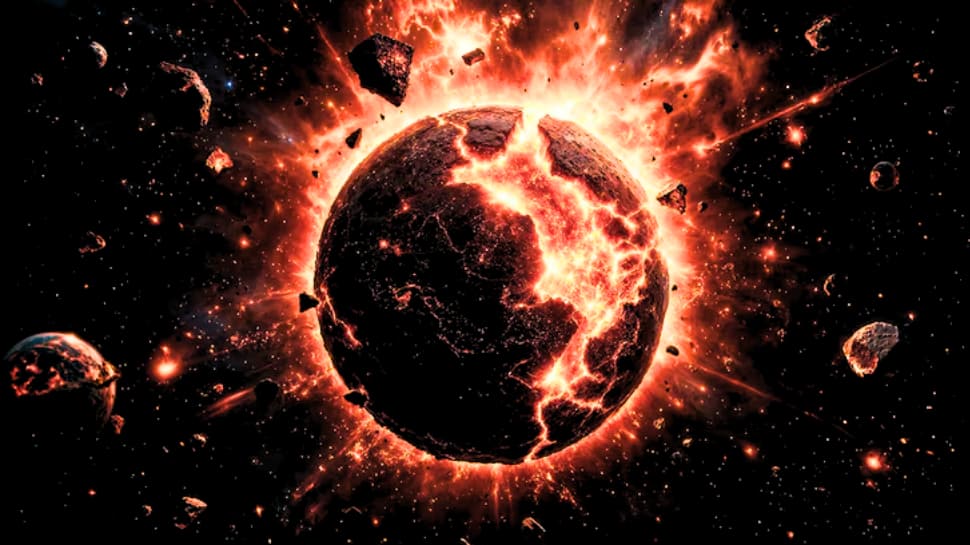World
Scientists Predict Universe’s Dramatic Collapse in 20 Billion Years

A groundbreaking analysis from physicists at Cornell University suggests that the universe may not continue expanding indefinitely. Instead, it could be on a path toward a dramatic collapse within the next 20 billion years. The study, led by S.-H. Henry Tye, introduces a model indicating that cosmic expansion will reverse in approximately 10 billion years, culminating in a catastrophic event known as the Big Crunch.
The research fundamentally challenges the long-held belief that the universe will grow increasingly cold and empty over time. According to the findings, which were published in the Journal of Cosmology and Astroparticle Physics, the universe is accelerating toward a singularity where all matter, including galaxies and planets, will compress into an extreme state.
Dark Energy’s Role in Cosmic Fate
Central to this paradigm shift is the concept of dark energy, the enigmatic force believed to drive the universe’s accelerating expansion. For years, scientists thought dark energy was both constant and positive. However, new observations from the Dark Energy Survey (DES) in Chile and the Dark Energy Spectroscopic Instrument (DESI) in Arizona challenge this assumption. The data suggests that the cosmological constant (Λ) could be negative instead of positive. This revelation implies that dark energy might eventually pull the universe inward, allowing gravity to regain dominance and reverse the current expansion trajectory.
Co-author Dr. Yucheng Qiu emphasized the significance of this research, stating, “We’re not just learning how the universe started. We’re learning when—and how—it ends.” This prediction diverges sharply from the widely accepted Big Freeze scenario, where the universe would simply grow cold and lifeless without reaching an endpoint.
Theoretical Model and Future Implications
The model predicting this collapse includes ultralight axions, hypothetical particles thought to be integral to both dark matter and dark energy. In Tye’s framework, these axions evolve gradually over cosmic time, potentially transforming dark energy from a supportive force to a destructive one. Under this model, the predicted timeline for cosmic events is as follows: expansion halts in approximately 10 billion years, contraction accelerates over the subsequent 9 billion years, and ultimately, everything collapses into a Big Crunch after around 20 billion years.
While the model is theoretical, it is supported by compelling data from DES and DESI, which are among the most ambitious cosmological surveys conducted. By analyzing the positions and movements of millions of galaxies, these studies indicate that the universe exhibits properties consistent with a negative cosmological constant and the influence of axions. Despite this, researchers recognize the substantial uncertainties that remain, particularly since axions have yet to be directly detected, and dark energy continues to be one of the most perplexing phenomena in physics.
Looking ahead, the scientific community anticipates further observations that could either reinforce or challenge this model. Upcoming missions like NASA’s SPHEREx, the European Space Agency’s (ESA) Euclid, and the Vera C. Rubin Observatory are expected to provide unprecedented insights into the nature of dark energy. These results may either confirm the collapse model or necessitate a reevaluation of our understanding of the universe’s structure.
The notion that “everything will disappear” is evolving from a philosophical perspective to one grounded in scientific inquiry. This research places the universe’s fate on a calculable timeline, suggesting that if dark energy is indeed evolving and its forces changing direction, cosmic expansion may be a temporary phenomenon rather than an eternal one. As of now, the universe continues to expand, albeit slowly, but new data indicates that this expansion might be weakening. Whether this signals the start of a countdown to a definitive end or reflects a misinterpretation of dark energy remains a pivotal question.
What is clear is that the debate surrounding the ultimate fate of the universe has been reignited, now armed with concrete figures and a timeline that invites further exploration and discussion within the scientific community.
-

 World4 months ago
World4 months agoSBI Announces QIP Floor Price at ₹811.05 Per Share
-

 Lifestyle4 months ago
Lifestyle4 months agoCept Unveils ₹3.1 Crore Urban Mobility Plan for Sustainable Growth
-

 Science4 months ago
Science4 months agoNew Blood Group Discovered in South Indian Woman at Rotary Centre
-

 World4 months ago
World4 months agoTorrential Rains Cause Flash Flooding in New York and New Jersey
-

 Sports4 months ago
Sports4 months agoBroad Advocates for Bowling Change Ahead of Final Test Against India
-

 Top Stories4 months ago
Top Stories4 months agoKonkani Cultural Organisation to Host Pearl Jubilee in Abu Dhabi
-

 Science4 months ago
Science4 months agoNothing Headphone 1 Review: A Bold Contender in Audio Design
-

 Top Stories4 months ago
Top Stories4 months agoAir India Crash Investigation Highlights Boeing Fuel Switch Concerns
-

 Sports4 months ago
Sports4 months agoCristian Totti Retires at 19: Pressure of Fame Takes Toll
-

 Business4 months ago
Business4 months agoIndian Stock Market Rebounds: Sensex and Nifty Rise After Four-Day Decline
-

 Politics4 months ago
Politics4 months agoAbandoned Doberman Finds New Home After Journey to Prague
-

 Top Stories4 months ago
Top Stories4 months agoPatna Bank Manager Abhishek Varun Found Dead in Well









